
Frequently Asked Questions
Things to consider before buying a pizza oven.
Where does pizza originate?
Pizza is an ancient dish: the Etruscans, Egyptians, Greeks and Romans all made their version of flat bread, pizza’s ancestor. In addition, there are records showing that risen dough was cooked in various ways, served with both sweet and savory ingredients, throughout both the Middle Ages and the Renaissance. However, the recipe that made pizza famous throughout the world comes from 17th century Naples. In fact, in 1730 tomato sauce was added to the typical Neapolitan flat bread, making it one of a kind. From that moment forth, small shops began opening around the city that served pizza with tomato sauce. Only at the beginning of the 20th century did Neapolitan pizza being to spread throughout Italy and, thanks to Italian emigrants, throughout the rest of the world. This is how it arrived in the US, especially in the cities with high numbers of Italian Americans, like New York, San Francisco and Chicago. Over the course of time, it has become one of the most well-known and loved imported Italian foods in the world.
Why buy a wood fired oven?
If you’re considering building a wood fired oven for your home or business, there are a few things you probably already know – the way the sight, sound, gentle warmth and vitality of fire ignites your spirits, how the wood fired aroma awakens your senses, and the pure excitement you feel when cooking with a live fire.
What you may not know is how to find the perfect match. Over the years, we’ve come to the understanding that a harmonious relationship between a cook and their oven is vital. The connection is a key ingredient in wood fired baking creativity, inspiration and success.
Where would I put my oven?
If you’re established in one area, and can’t imagine yourself moving anywhere else anytime soon, building an oven into the existing architecture of your home or business is a great option.
On the other hand, for those who never settle, or who may move around, we strongly suggest a model that has the capability to travel along with you. Look into some our turnkey concepts like a portable oven. These ovens are fully assembled and ready to use immediately. They are priced higher than some of the basic oven core packages, but the beauty is you can make the investment without feeling tied down. Enjoy wood fired baking knowing that if you need to move the oven around the garden or even to a new garden – you can!
How do I choose the size of my oven?
Really, you’re choosing the size of the cooking area – This is known as the stone or hearth and it all depends on the volume of food you’ll be baking on a regular basis. If you love to cook outdoors for friends and family or are looking for a commercial oven you would be wise to invest in an oven with a large stone area for cooking. This means that you’ll be able to cook a lot of food in the least amount of time without sacrificing flavour, quality or authenticity. Remember to take into account how much of the stone space the wood you will need to heat up the oven (and keep the oven hot) will take up. If you are cooking for up to 6 people, chose an oven with a stone at least 75cm wide x 50cm deep. If you plan on cooking for less people, then a smaller stone will work well for you. When you’re browsing through different models, just be sure to examine the specs closely because they’ll give you a good sense of the cooking surface and capacities of each oven – but remember to always allow for the space your wood will need within the oven itself.
The better ovens will have an effective heat circulation and insulation system, so will therefore need less wood at any time to create the heat necessary to cook. This point is important because wood takes up space within the oven. To create and retain a temperature up to 300°F you will need an area, to the side of the stone (within the oven itself) at least 25cm wide x 50cm deep. Take this away area away from the stone size to give you the actual cooking area of the stone left to cook on. On first glance, some ovens look deceptively big. But by the time you’ve got your fire going and pushed to the side, there isn’t a great deal of cooking space at all.
One piece of advice we often give is to not only think about what type of capacity you need now, but also what type of capacity you may need 5-10 years down the road. It’s better to leave room for growth personally or professionally, rather than purchasing an oven that ends up being too small and stifles your potential.
How do I know if the oven will be effective?
The oven core material, which insulates the oven from heat loss, is one of the most important factors in maintaining the cooking temperature within your oven. To achieve the maximum amount of efficiency, look for ovens that use Terre Blanche (white clay), terracotta, dense firebrick, and cold cast refractory concrete as insulation. These materials al have fantastic thermal properties, and offer outstanding efficiency & durability.
These specific materials are industry approved and recommended and have been tested to meet all UL 2162, ULC S627-00 and ANSI/NSF 4 standards. This means, food can be placed directly on the hearth tiles because the organic properties do not denature it in any way, not even at high temperatures. We have designed our ovens making sure that all food cooked will remain completely wholesome with the taste, flavour and the aroma fully preserved. When researching different oven core materials, definitely keep your eyes peeled for food safety testing, UL and ULC seals of approval.
What shape and design is best?
The design of your oven core is as equally important as the material. Make sure to do your research here. A common mistake is to go with a model that may be less expensive, but also lacks enough mass and capability to absorb and retain the amount of heat needed to cook both evenly and efficiently.
Unique dome shaped ovens allows air to enter through the bottom of the oven and circulate naturally, ensuring perfect combustion, while the smoke is expelled through the top. This creates the precise convection airflow to feed your fire, and cook every dish to perfection. But beware – make sure the dome is insulated with approved thermal materials.
The wall thickness and weight of the core are also very important elements to consider. We find when comparing our wood fired ovens to others on the market that our wall thickness, insulation, thermal qualities of our stone and weight of the core far exceeds those offered by other brands.
When crunching numbers, try dividing the price of the oven by the total weight. Know what you’re getting per pound when comparing brands and narrowing down your options. One final tip is to look out for ovens that are easy to clean once the food is finished and all of your guests have gone. You’ll have to remove the ash from inside the oven and scrape any food residue that is left on the stones.
Buying an oven which allows you to store your wood and cooking utensils is always handy – but ovens which have built-in shelves are only designed as a temporary storage area for your wood - remember that the wood needs to be dry before its burnt
How much should I spend?
If you can afford it and have the space – buy an oven, which will be large enough for a 12’ pizza and have space for any accompaniments you foresee cooking alongside the pizza. If you are looking for value for money and want to avoid disappointment, please check out the points and tips we have already covered – the insulation value of the inner core, the size of the cooking stone and making sure the cooking stone has the approved industry properties. Outdoor cooking and alfresco dining is an amazing experience, both for the chef and his guests. We’d like to encourage and further develop this beautiful pastime. In order that everyone participate and continues to promote and endorse the outdoor lifestyle, it would be wonderful if everyone bought one of our wood fired ovens. We know it will last you are lifetime and bring yourself, your family, friends and guests terrific satisfaction and fabulous entertainment. So if you are considering buying a pizza oven, please choose carefully and make sure you only have to buy one. Not like the old days when we all went through at least 6 different outdoor barbeques, wishing we’d have spent a little more in the first place.
There are a myriad of wood types to choose from, all of which have their own burning qualities and properties and although there are references to burning green wood in this guide, we would stress that for the most efficient and effective burn in your wood burning stove only very dry wood should be used. In addition there are of course the compressed reclaimed 'eco' type of logs and briquettes. These tend to burn well and for a decent length of time because they are dense and very dry, however try to choose a product that does not break apart too easily.
Hardwood or Softwood?
Do you know the difference between hardwood and softwood? Hardwoods are any broad-leafed, deciduous trees, such as Beech and Elm, while softwoods are conifers including Cedar and Fir.
When it comes to burning wood in stoves or ovens, hardwood is better than softwood as it burns slower. The density of softwood is also around half that of hardwood, which results in it burning twice as fast – meaning you’ll need twice as much!
The best wood for cooking and how it affects the flavour of your cooking:
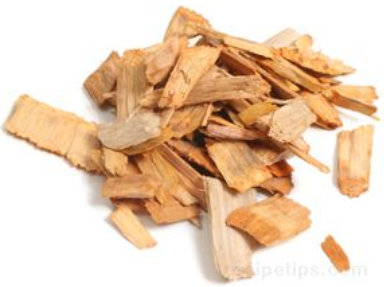
Alder
Alder is most often used for grilling and smoking salmon. It is also used for other species of fish, poultry, small game birds, and pork, providing a subtle, sweet flavour to the meat.
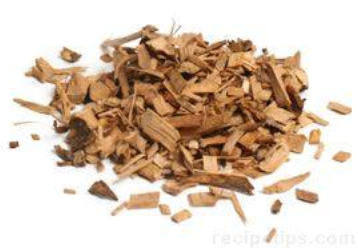
Apple
Apple wood provides a sweet, fruity flavour to most meat but is especially good for smoking ham. The wood is dense and very hard in texture.
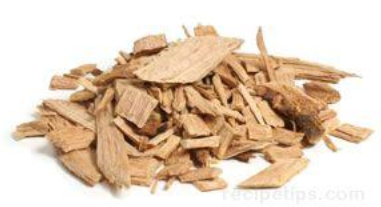
Beech
Generally readily available, this hardwood provides a flavour similar to oak and several other hardwoods. The wood of the beechnut produces a mild, somewhat delicate smoked flavour. Since it is a hardwood, it remains longer for smoking before it turns to ash.
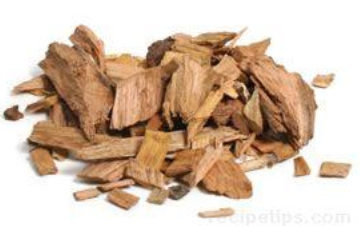
Blackberry
Much like the woods provided from fruit trees, the small diameter trunks of the blackberry bush provides a slightly sweet and delicate flavour for grilling poultry and other meats, such as small game birds like grouse, pheasant, partridge, and quail.
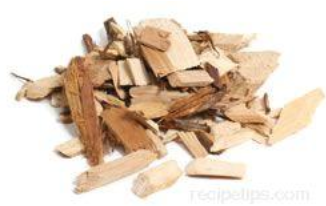
Cedar
A very common wood used to grill fish, poultry and various meats such as pork and beef. White or red cedar is the species most often available, which provide a distinctive natural and aromatic flavouring for a variety of foods. Salmon and other types of fish are often grilled or smoked using cedar.

Cherry
Cherry is used for all types of meat and like apple; it provides a subtle, sweet, fruity flavour to foods. Cherry can be used to grill and smoke turkey, chicken, small game birds, and pork.

Corncob
Although not considered to be a true wood, it is often used as a smoking chip when grilling foods such as poultry, fish and small game birds. The heart of the cob that holds the kernels is the fuel section of this alternative for wood. It is ground into small granular bits that can be added to a smoking box or it can be combined with other woods such as woods from fruit trees, to impart several flavours. The Corncob provides a sweet flavour that may overpower the food if too much is used to season the food as it cooks. Begin by trying small amounts until the desired flavour is achieved.
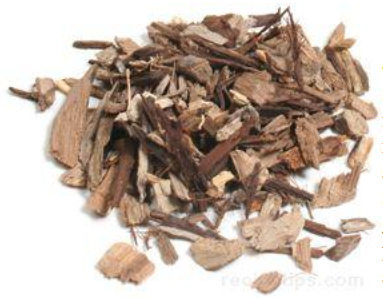
Grape Vine
Small in size, the chips from matured grape vines provides a flavour that is much like other species of trees bearing fruit. Somewhat sweet and fruity, the grape vine is most often used for poultry, small game birds, pork and sausage.
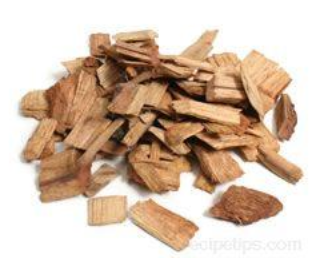
Hickory
Hickory is more common in the South, but is popular in many regions. It is used just as often if not more often than oak. Hickory provides a strong smoky bacon flavour and can be used for all types of meat, but is especially good for cuts of pork, wild game, chicken, and ribs.
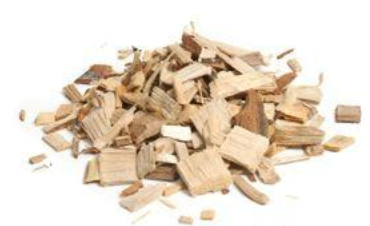
Maple
Maple provides a mild, smoky and somewhat sweet flavour to foods. It is best used with pork, poultry, small game birds, and is often considered to be a good wood for grilling vegetables.

Mesquite
Mesquite burns very hot and provides a strong flavour to foods. Because of its more intense heat properties, it may burn too hot for some foods. It is very popular in Texas and the Southwest United States where it is most often used for grilling or smoking cuts of beef; however, it is also a good choice for a variety of other meats and vegetables as well.
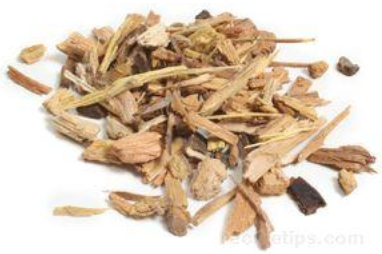
Mulberry
When mulberry wood is burned, it produces a sweet smelling smoke similar to apple. It is a good choice for imparting flavour into poultry, fish, and pork.
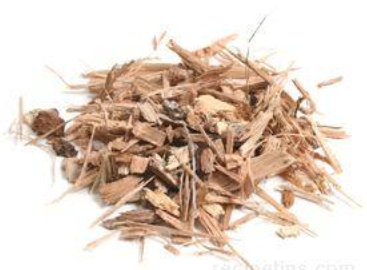
Oak
Oak is one of the most often used woods because it is common in many regions of the country. It provides a good flavour without overpowering the food. It is used for all types of meat, poultry, and fish.

Peach
Similar to other fruit trees, the wood from a peach tree provides a somewhat sweet, fruity flavour. It is most often used for grilling pork or poultry; however, small game birds such as grouse, partridge, and quail are often grilled or smoked with peach wood chips.

Pear
Similar to peach and other fruit trees, the wood from a pear tree provides a somewhat sweet, fruity flavour. It is most often used for grilling pork or poultry; however, small game birds such as grouse, partridge, and quail are often grilled or smoked with pear wood chips.

Pecan
Pecan is popular in Louisiana and other Gulf Coast states. It provides a flavour similar to hickory, but not quite as strong. It can be used with most cuts of meat.
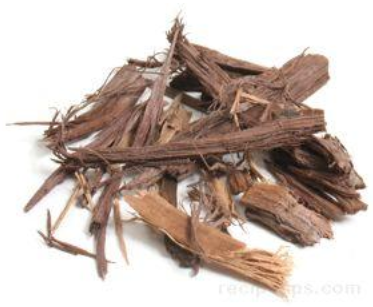
Walnut
Walnut is best used for red meats and strong tasting, heavy game because of the strong and somewhat bitter flavour it provides. It is often mixed with woods with milder flavours in order to provide a more subtle flavour to foods.
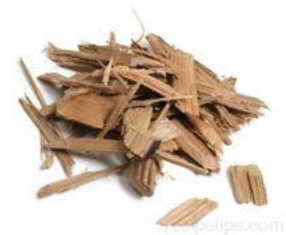
Wine or Whiskey Barrels
Woods that have been seasoned with aged beverages such as wine or whiskey impart the flavours of the blends through the years of use. Most often made from oak, the wood provides a light oaky taste that goes well with beef, poultry, and cheeses that are grilled or smoked.
Birch
A softer wood, birch is best used when grilling or smoking cuts of pork and poultry, providing a flavour similar to some varieties of maple.
Pimento
Pimento is a tropical wood taken from the plant, Pimenta dioica, which is also referred to as Allspice, Jamaican Pepper, Myrtle Pepper, or Newspice. In some regions where this is available, the Pimento wood is used for grilling poultry and fish. Pimento wood adds a natural peppery flavour to food and it may also impart the flavours of several combined spices, such as cinnamon, cloves, and nutmeg, which is similar to the flavour provided by allspice. Pimento is commonly used when grilling Jamaican foods such as jerk chicken.
Seaweed
Although not often thought of as a type of wood, seaweed is commonly used for smoking shellfish, such as clams, crab, lobster, mussels, and shrimp. The seaweed is washed to remove the salt and is then air or sun dried before use. It provides a somewhat spicy and natural flavour to the foods being smoked or grilled.
Different wood and how it performs when it burns:
| Alder | Produces poor heat output and it does not last well. |
| Apple | A very good wood that burns slow and steady when dry, it has small flame size, and does not produce sparking or spitting. |
| Ash | Reckoned by many to be one of best woods for burning, it produces a steady flame and good heat output. It can be burnt when green but like all woods, it burns best when dry. |
| Beech | Burns very much like ash, but does not burn well when green. |
| Birch | Produces good heat output but it does burn quickly. It can be burnt unseasoned, however the sap can cause deposits to form in the flue with prolonged use. |
| Cedar | This is a good burning wood that produces a consistent and long heat output. It burns with a small flame, but does tend to crackle and spit and the sap can cause deposits to form in the flue with prolonged use. |
| Cherry | This is a slow to burn wood that produces a good heat output. Cherry needs to be seasoned well. |
| Chestnut | A poor burning wood that produces a small flame and poor heat output. |
| Firs (Douglas etc) | A poor burning wood that produces a small flame and poor heat output and the sap can cause deposits to form in the flue with prolonged use. |
| Elm | This is a wood that can follow several burn patterns because of high moisture content, it should be dried for two years for best results. Elm is slow to get going and it may be necessary to use a better burning wood to start it off. Splitting of logs should be done early. |
| Eucalyptus | This is a fast burning wood. The sap can cause deposits to form in the flue and can increase the risk of a chimney fire if burned unseasoned. |
| Hawthorn | This is a good traditional firewood that has a slow burn with good heat output. |
| Hazel | This is a good but fast burning wood and produces best results when allowed to season. |
| Holly | This is a fast burning wood that produces good flame but poor heat output. Holly will burn green, but best dried for a minimum of a year. |
| Hornbeam | A good burning wood that burns similar to beech, slow burn with a good heat output. |
| Horse Chestnut | A good wood for burning in wood stoves but not for open fires as it does tend to spit a lot. It does however produce a good flame and heat output. |
| Laburnum | A very smokey wood with a poor burn. |
| Larch | Produces a reasonable heat output, but it needs to be well seasoned. The sap can cause deposits to form in the flue with prolonged use. |
| Laurel | Burns with a good flame but only reasonable heat output. It needs to be well seasoned. |
| Lilac | Its smaller branches are good to use as kindling, the wood itself burns well with a good flame. |
| Maple | This is a good burning wood that produces good flame and heat output. |
| Oak | Because of its density, oak produces a small flame and very slow burn, it is best when seasoned for a minimum of two years as it is a wood that requires time to season well. |
| Pear | Burns well with good heat output, however it does need to be seasoned well. |
| Pine | (Including Leylandii) Burns with a good flame, but the resin sap can cause deposits to form in the flue and can increase the risk of a chimney fire must be well seasoned. |
| Plum | A good burning wood that produces good heat output. |
| Poplar | A very smokey wood with a poor burn. |
| Rowan | Is This is a good burning wood that has a slow burn with good heat output. |
| Robinia (Acacia) | This is a good burning wood that has a slow burn with good heat output. It does produce an acrid and dense smoke but this is of course not a problem in a stove. |
| Spruce | Produces a poor heat output and it does not last well. |
| Sycamore | Produces a good flame, but with only moderate heat output. Should only be used well-seasoned. |
| Sweet Chestnut | The wood burns ok when well-seasoned but it does tend to spit a lot. This is of course not a problem in a stove. |
| Thorn | This is one of the best woods for burning. It produces a steady flame and very good heat output, and produces very little smoke. |
| Willow | A poor fire wood that does not burn well even when seasoned. |
| Yew | A good burning wood as it has a slow burn, and produces a very good heat output. |